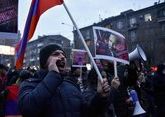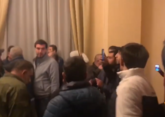On July 26, Armenia’s Special Investigation Service charged former Armenian President Robert Kocharian with overthrowing the constitutional order within the criminal case related to a crackdown on antigovernment protesters on March 1, 2008. A day later he was placed into custody for two months. Kocharyan stood at the origins of the separatist movement in Karabakh, was the first "president" of the self-proclaimed NKR, and served as the president of Armenia for 10 years. The international Russian-language television channel RTVI recalls the events resulting in imprisonment of Armenian ex-president.
Kocharyan was a witness in the case on the crackdown on demonstrators in Yerevan in March 2008, when 10 people were killed. This interrogation is interesting because the Special Investigation Service earlier said that there was no need for it, and Kocharyan won't raise anything new. In early July, charges of 'usurping state power' were filed against former Defense Minister Mikael Harutyunyan in connection with the events of 2008. He was declared wanted.
The investigation of the case was speeded up after the change of power in Armenia. Kocharyan arrived for an interrogation incognito and used a secret door to leave the Investigation Service's building. It is not yet known what Robert Kocharian said, answering the questions of the investigators in the 2008 case. But even then it was clear that the country's former president was five minutes from the arrest.
A series of mass protests in 2008 began immediately after Armenia's presidential election. On February 20, 2008, the Central Election Commission announces the victory of Serzh Sargsyan. But his political rival, the first president of Armenia, Levon Ter-Petrosyan, said that the victory was stolen from him. And thousands of people, who believed that violations were committed during the elections, blocked central Yerevan - 12 days of peaceful protest actions. Up to half a million people went out on the streets.
Now we know - Armenia's army authorities, power structures had already made their choice and were prepared to disperse the demonstrators. There were last days of Robert Kocharyan's presidency. According to the constitution, he could not run for a new term, but fully supported his successor Sargsyan. When Yerevan was encompassed by protest actions, Kocharyan was in Moscow at the CIS summit and ruled the country from there.
"The incident was unacceptable - in fact, the army was drawn into post-election political processes, which represented a real threat to the constitutional order. Urgent measures were needed," Kocharian said.
It is not known with accuracy what measures Kocharyan was undertaking. But the fact remains. Early in the morning on March 1, 2008, police using electric-shock batons dispersed demonstrators, including women, children and the elderly. It caused mass clashes between Ter-Petrosyan supporters and security officials in the city. Around 12 o'clock, protesters gathered near the French embassy in the center of Yerevan. Activists rolled trolleybuses and buses to make a barricade. The number of demonstrators increased, and the police retreated. But at ten o'clock, President Robert Kocharian, after the approval of the parliament, introduces a 20-day state of emergency in the country that prohibits any demonstrations. Later, violent clashes broke out between representatives of law enforcement agencies and demonstrators in central Yerevan, against which were used firearms.
"You cannot even imagine six months ago that laws will work for all in Armenia. That is, no special people, no outlaws. Robert Kocharyan was summoned to an investigation. Tomorrow they may summon Serzh Sargsyan. This is very important.
10 people were killed in those clashes. According to the representatives of the Armenian opposition, the March 2008 events were a real shock for them. The authorities used firearms for the first time against the protesters," political scientist Stepan Grigoryan said.
Now, 10 years after those events, after the "velvet revolution" in Armenia, as a result of which opposition leader Nikol Pashinyan became prime minister, it was possible to resume the investigation.










